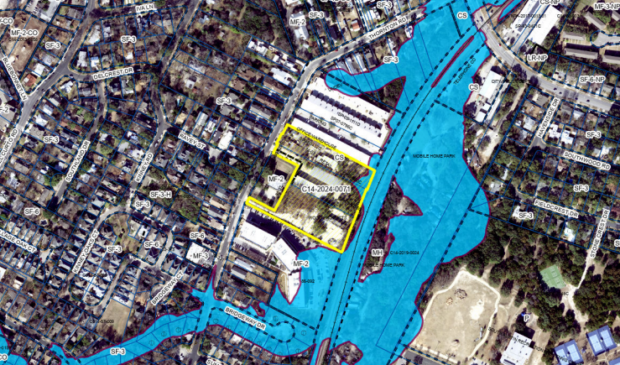About the Author
Jo Clifton is the Politics Editor for the Austin Monitor.
Newsletter Signup
The Austin Monitor thanks its sponsors. Become one.
Most Popular Stories
- Dozens of city music grants stalled over missing final reports
- City leaders evaluate surprising ideas for water conservation
- Audit: Economic official granted arts, music funding against city code
- Parks Board recommends vendor for Zilker Café, while voicing concerns about lack of local presence
- Council reaffirms its commitment to making Austin a more age-friendly city
-
Discover News By District
Popular Whispers
Sorry. No data so far.

Photo by city of Austin
Revised Thornton Road rezoning gets first reading approval
Friday, October 4, 2024 by Jo Clifton
After a surprise change in the requested zoning, City Council approved on first reading a much smaller zoning change for a 4-acre site on Thornton Road in South Austin. The property sits in District 5, and Council Member Ryan Alter played a major role in putting together a different zoning plan than what the property owner had envisioned. The new zoning for the property is multifamily-6 with a conditional overlay, eliminating commercial zoning and limiting the height and impervious cover. It was the last action of the evening on Sept. 26, and Council members Paige Ellis and Alison Alter did not participate.
Neighbors had been protesting the originally requested DB90 zoning, which would have allowed 90 feet in height. They had gathered a petition against it. However, staff said the petition was insufficient to trigger the three-fourths vote requirement. Still, neighbors sat for hours at the meeting waiting to tell Council about the traffic problems, among other things, the new construction would cause those already living there.
It was news to the neighbors when attorney Michael Whellan announced during his presentation to Council that they would not be pursuing the density previously requested – which would have meant construction of a 90-foot building with apartments as well as commercial services. Staff had recommended general commercial services-vertical mixed-use building (CS-V) combining district zoning. However, the Planning Commission recommendation was in line with the applicant’s request for DB90.
Whellan explained that he and his client had reached a decision on the path forward only earlier in the day. He said the property has been used for commercial and industrial uses for 75 years.
“Today, our existing CS (general commercial services) zoning by right allows up to 60 feet of height, 95 percent impervious cover, 95 percent building coverage and a variety of commercial uses,” he said. Those uses, he said, could include “a hotel, motel, gas station, car repair shop, limited warehousing and distribution or recycling collection facilities.”
However, he added, “The one thing it does not allow is housing, which is what we are proposing to accomplish. We initially requested DB90 zoning with a ground floor waiver to provide a fully residential building at a unit count that would support project feasibility,” he said. Whellan pointed out that there are a number of other multifamily and commercial properties around his client’s property. The site in question is close to railroad tracks and there are mobile homes on the other side of those. He also argued that there are a number of different ways out of the neighborhood. Most people would go toward Oltorf Street, but despite the fact that there are bus stops on that street, there is no traffic light at that intersection.
Neighbors told Council via email and in person how dangerous it would be for them to have the 90-foot building and its accompanying traffic added to their street. Leah Brown, a city employee, expressed her own concerns, as well of those of neighbors, in an email to Council. She wrote, “The large multi-family developments and high rises going up directly on South Lamar the last few years have greatly already changed our neighborhood and our streets, making it more difficult to safely get in and out of our neighborhood, and have already effected the quality of life here for many. Many of us moved to this neighborhood knowing change would happen – but choose living south of the river to avoid being next to high rises, major traffic, and constant noise/light. Keeping this project to a major street, like Lamar (while not without other issues) is one thing – but bringing this to a small neighborhood street that cannot take on any more cars and traffic and people is another and is an extremely upsetting and unsafe proposal that will likely result in more accidents, a major decline in quality of life, destruction of green space and habitats, a potential for more flooding, not having adequate ways to and from our homes, and likely lead to many people deciding to leave.”
Whellan said he had been assured by the city’s Transportation Department that there would be a traffic light installed at that intersection. However, as with many things related to traffic, it was impossible to know exactly when that might happen. He did stress that his client would be helping to pay for that light.
Council Member Ryan Alter made the motion to adopt the new zoning, indicating that he had been working on a solution to the zoning conundrum for a while. He thanked neighbors for their patience and explained that they had invited him out to look at the site.
“And when I was out there, it was very clear – I think pretty quickly – that 90 feet was just way too much for this area,” he said. He said they had “scrambled to try to put a deal together” that day that would reduce the impervious cover and the footprint of the building. He noted that there was still some time to work on the zoning, which would include discussions with city engineers about improvements that might be needed to Thornton Road. Overall, he indicated that the zoning was now on the right path.
The Austin Monitor’s work is made possible by donations from the community. Though our reporting covers donors from time to time, we are careful to keep business and editorial efforts separate while maintaining transparency. A complete list of donors is available here, and our code of ethics is explained here.
Posted In: Development, Zoning, District 5
You're a community leader
And we’re honored you look to us for serious, in-depth news. You know a strong community needs local and dedicated watchdog reporting. We’re here for you and that won’t change. Now will you take the powerful next step and support our nonprofit news organization?



